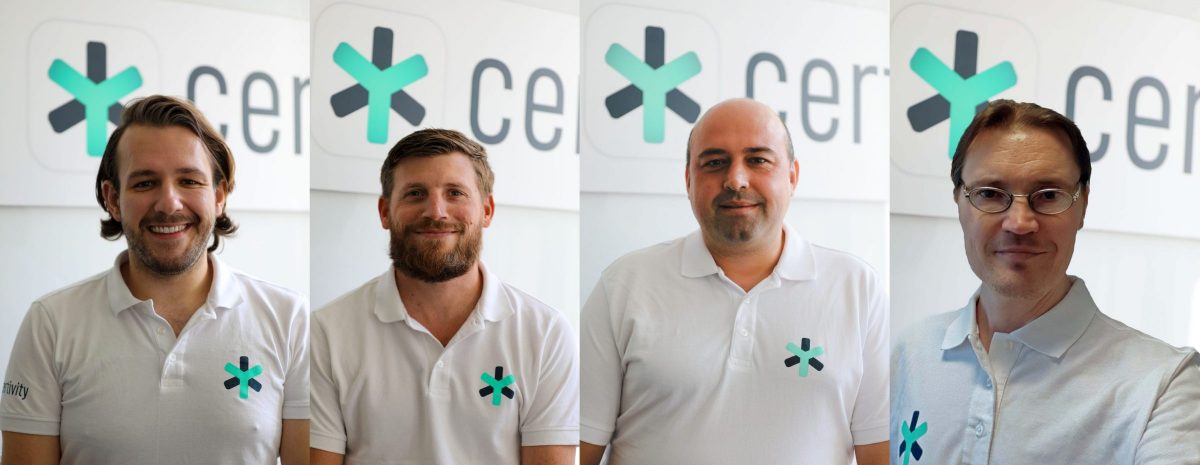Munich Startup: Who are you and what do you do? Please introduce yourselves!
Nico Wägerle, Certivity: I’m Nico Wägerle (31). I’m a lawyer and worked in the automotive industry for six years in various positions as a lawyer. Some of the areas I worked in at that time were data protection and autonomous driving. We then have Bogdan “Bob” Bereczki (45). He is an aerospace engineer and also worked in product compliance in the automotive realm for quite a long time, which is where he both co-developed and certified regulations, a process that is called homologation in the automotive industry.
Sami Vaaraniemi (56) is a software engineer through and through. He studied computer science, helped build the Azure Cloud at Microsoft and also worked for other top-tier companies such as Skype, Citeo and Nokia.
And then we have Jörg Ulmer (38), who is also a software engineer and worked for various companies in the software industry. He has also already founded a company, the startup Midiaid, a midwife contact platform.

How did we meet? Bob and I knew each other from our former jobs at Autonomous Intelligent Driving GmbH in Munich. I worked in the legal department and Bob was in product certification. That was also where we met Sami, but only briefly, because we never worked together on a professional basis. At the point in time that we were ready with our company and posted our first product ideas, Bob and I were initially working with a different software developer. But after a certain amount of time, we went our separate ways. During our search for new software engineers and developers, we posted our job offers in a WhatsApp group of former AID employees. Sami replied to the offer and took on the job as Co-Founder & Chief Software Officer.
It was also during that time that we met Jörg through an accelerator program that we participated in known as “Steyg Next” in Stuttgart. Jörg took part with his company Midiaid. When he heard that we were looking for support in software, he immediately got in touch with us.
“During development, you have to incorporate the applicable vehicle regulations into the development process”
Munich Startup: What problem does your startup solve?
Nico Wägerle: Here at Certivity, we’re developing an automotive regtech solution, in other words, software technology that supports the compliance process. The problem is that cars are highly regulated, and more than 2,500 different vehicle regulations are applied to cars worldwide. Another aspect in the EU is that a car has to be certified before it even hits the market. This is known as type approval or homologation. And it’s why during development, you have to incorporate the applicable vehicle regulations into the development process.
On top of that, the regulatory world for cars is extremely international in nature. The United Nations is the legislator for the biggest market with the United Nations Economic Commission for Europe (UNECE). It drafts vehicle regulations that are then applied in the European Union and in many other countries. But then the US or China, for example, have their own rules and legislative systems that work a bit differently.
So if I’m developing something as an engineer, I first have to find out which regulations apply to the entire vehicle, my system, my components or whatever I might be building. Then I have to extract the requirements from the product regulations and integrate them into the development process. And then as a third step – perhaps because the regulation isn’t clear – you usually have to interpret the regulation with a lawyer or a regulatory officer. That was what both Bob and I did, for example, and we worked in very close collaboration with the engineers.
Regulations change three to four times a year
After I’ve completed all that, something still might change in the regulation. That is very often the case in the automotive field, it can happen three to four times a year. Then I have to start all over from square one. That means as an engineer, I always have to be informed about changes. I have to see if it has an impact on the regulations that apply to me and, if I arrived at an interpretation based on the old regulation, potentially interpret it all over again.
All of these process steps are still mainly performed by people, which means they’re very manual and there isn’t a proper tool for them. And that’s a problem, because it’s extremely labor-intensive and engineers are confronted with tasks that don’t require their core competencies as engineers. We’re solving that problem with Certivity by building a software platform that is responsible for regulatory management and takes care of the majority of these tasks for engineers.
And the more complex the systems in the vehicle are, the more complex these tasks become. At the moment, for example, there is whole lot of software and electronics being put into cars, such as automatic emergency braking systems or lane assist systems that keep the vehicle in its lane with sensors and steering and brake intervention. It’s not just the systems that are complex, but also the regulations. Manual processes make it all very difficult and very extensive. That’s why now is the right time for our solution. We’re putting a product on the market that significantly reduces the complexity of it all.
Certivity creates digital data models using regulations
Munich Startup: But that’s nothing out of the box!
Nico Wägerle: The work that’s currently being performed is much more expensive and complicated. We’re digitizing regulatory content: We take what has been available as a PDF until now and turn it into a data model broken into paragraphs. This allows us to add many attributes. What that means is that, unlike database companies, we don’t provide a PDF, but rather regulatory elements that you can put together to create a regulatory model for a real product. Moreover, you can also link our model with other development tools and interact with them.
Take the development of an automatic emergency braking system as an example, which is mandatory in the European Union. If an obstacle is identified on the road but there is no brake intervention, the vehicle has to be able to brake automatically. Aspects such as brake intervention or deceleration, for example, are regulated in technical regulations. Now on our platform, I would apply the set of requirements from the UN regulation for this kind of system. And because I also want to expand to China, I would also use the corresponding set of requirements. I can put it all together in a regulatory system model that maps out my product. If something changes in the regulations, we can enter that directly and apply it to the model and work on the product design again if necessary. This makes it easy for us to always keep the model up-to-date for engineers.
“It’s easy for us to always keep the model up-to-date”
Moreover, we can store all questions and interpretations in the model or based on a specific paragraph. For example, if a regulation requires a visual and acoustic warning signal when a system is engaged, then engineers ask themselves what that means exactly for actual implementation.
On our platform, I can ask these questions and store the answers in a system model in the paragraph where it belongs and save it for transparent use in the future. Email was used for that until now, and emails often got lost somewhere in the inbox of the regulatory officer or developer. And that makes it difficult to remember how you arrived at a particular interpretation.
Munich Startup: What was your biggest challenge so far?
Nico Wägerle: Working with automotive companies. Just getting through the onboarding process with them is definitely challenging – especially as a young company that needs to build traction quickly. We often had to go through different processes over a matter of five to six months for some proof-of-concept agreements.
Munich Startup: Where do you want to be in one year? What about in five years?
Nico Wägerle: We’re currently collaborating with several proof-of-concept customers, and more are in the sales pipeline. At the same time, we’re developing version 1.0 of our product. It should be ready in Q2 of next year so we can roll it out and generate the first recurring revenue. We would also like to have completed a funding round to ramp up the company.
In twelve months, we want to have recurring customers who use our software.
Certivity already has its sights set on additional industries
In five years, we want to be even more deeply integrated into the automotive field. That’s because our regulatory model – once it’s been built – can do much more. For example, it can also cover the supporting documents to prove regulations have been complied with. We also want to scale in the verticals with Certivity. We already have initial evidence of our concept being interesting for other industries as well. That’s why we would definitely like to expand the fields in which we offer our product.
Munich Startup: What do you think about Munich as a startup location?
Nico Wägerle: I think Munich is great! We founded the company during corona, which means we’re among the crazy people who actually gave up good jobs during the pandemic and dared to venture into the unknown. But Munich with its cool infrastructure gave us excellent support. We’re in contact with Baystartup and the Munich Urban Colab, for example. We also won 36,000 euros from Start?Zuschuss!. Off the top of my head, I haven’t come across any programs like that in Baden-Württemberg, which is where I’m from originally. We’re now in Werk1, where we’re able to rent office space at a very reasonable price. On top of that, Munich is extremely popular among all of the VCs. There’s something new happening every day, and it’s just a lot of fun.
Munich Startup: Car or bike?
Nico Wägerle: We’re definitely car enthusiasts considering how many automotive years we all have in common. For professional reasons, we think our products are quite attractive. I’m definitely a car fan for long distances, but am personally a big bike fan for short trips, especially in Munich. I really like riding my bike here.



